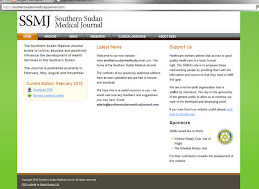I justed wanted mention a few points of progress regarding the improvement of acute care services in Juba. There's been some good consequences from my presentation to the Ministry of Health at GOSSHA2 (see previous blog entry) recently. Amongst other things, we clearly demonstrated in a mortality distribution study that 60% of inpatient mortalities (and 70% of paediatric mortalities) in JTH occur within the first 24 hours of admission. We concluded from this that in order to reduce hospital mortality, attention would be best spent on improving the acute care delivery services.
What's been really great is that people are actually taking this seriously. Dr Dario (my Consultant and Director General of JTH) has created a new permanent post in Juba: Director of Emergency Services, and appointed Dr Thomas to the task to coordinate it all. This is really encouraging and improving acute care is now high on the hospital's agenda.
Another good outcome from GOSSHA2 has been that Dr Dario managed to put forward as an official recommendation to the ministry that the current procurement system for hospital supply should be revised. Consistent supply of life-saving drugs and equipment, whilst we take it for granted back at home, is a huge issue here. There's few things more frustrating and upsetting as a clinician than seeing delays in, or worse still no treatment at all for a sick patient because there just are no, for example, venflons in the hospital. So in the old system we got what we were given by MoH rather than what we said we needed. Hopefully this will change and the hospital will have more autonomy in procuring supplies.
What's been really great is that people are actually taking this seriously. Dr Dario (my Consultant and Director General of JTH) has created a new permanent post in Juba: Director of Emergency Services, and appointed Dr Thomas to the task to coordinate it all. This is really encouraging and improving acute care is now high on the hospital's agenda.
Another good outcome from GOSSHA2 has been that Dr Dario managed to put forward as an official recommendation to the ministry that the current procurement system for hospital supply should be revised. Consistent supply of life-saving drugs and equipment, whilst we take it for granted back at home, is a huge issue here. There's few things more frustrating and upsetting as a clinician than seeing delays in, or worse still no treatment at all for a sick patient because there just are no, for example, venflons in the hospital. So in the old system we got what we were given by MoH rather than what we said we needed. Hopefully this will change and the hospital will have more autonomy in procuring supplies.
Enough from me - a few words from David now.
James
 The new emergency drugs cupboard on the Emergency Medical Ward.
The new emergency drugs cupboard on the Emergency Medical Ward.It may not look much but you wouldn't believe the amount of effort required...
“How was your day?” the Comboni’s often ask me at supper.
“Same as usual,” I often reply “Everyday we move two steps forward, one step backward and one step sideways. But always, we move one step forward!”
Yesterday we took three huge strides:
The purpose of the cupboard is to provide medicines at night time when there are no pharmacists and to allow access to life-saving medicines that you need within seconds. Currently, if a patient needed urgent treatment I would have to send a nurse to pharmacy. More likely than not the nurse would get side-tracked in vigorous hand-shaking and salutations, the Pharmacy would probably be shut, the Pharmacist would be out, or there would be no drugs. This lamentably slow process would take 15 minutes at best. At worst the word “Bukra,” would be given which is a word I hear rather frequently (it means “tomorrow”).
We have selected the Male Emergency Ward as our new Emergency Ward because it has two separate wings. One wing can be for females, the other for males. Handover and the drugs cupboard is in the middle. Today we have been moving the patients out of the Male Emergency Ward and redistributing them.
I am holding out high hopes. We have enough staff, they are all trained, we have the medicines and equipment we need. In the future, we will see if it impacts on mortality.
“Same as usual,” I often reply “Everyday we move two steps forward, one step backward and one step sideways. But always, we move one step forward!”
Yesterday we took three huge strides:
The purpose of the cupboard is to provide medicines at night time when there are no pharmacists and to allow access to life-saving medicines that you need within seconds. Currently, if a patient needed urgent treatment I would have to send a nurse to pharmacy. More likely than not the nurse would get side-tracked in vigorous hand-shaking and salutations, the Pharmacy would probably be shut, the Pharmacist would be out, or there would be no drugs. This lamentably slow process would take 15 minutes at best. At worst the word “Bukra,” would be given which is a word I hear rather frequently (it means “tomorrow”).
We have selected the Male Emergency Ward as our new Emergency Ward because it has two separate wings. One wing can be for females, the other for males. Handover and the drugs cupboard is in the middle. Today we have been moving the patients out of the Male Emergency Ward and redistributing them.
I am holding out high hopes. We have enough staff, they are all trained, we have the medicines and equipment we need. In the future, we will see if it impacts on mortality.
David



No comments:
Post a Comment